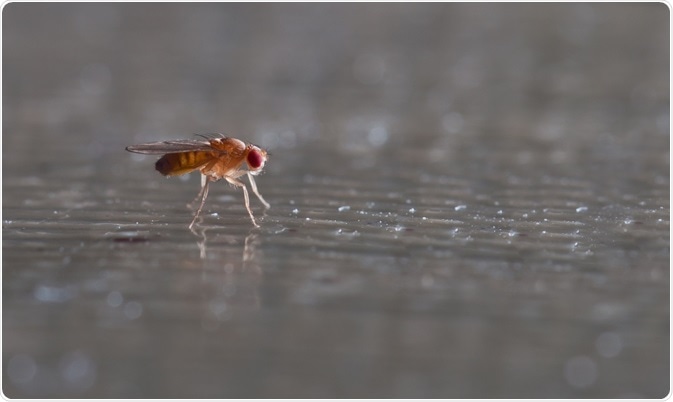Animal models enable scientists to explore human diseases while avoiding the ethical issues associated with human models.

Image Credit: Roblan/Shutterstock.com
A wide variety of animals have been previously used in animal testing, including mice, flies, and monkeys. A particularly useful model organism is Drosophila melanogaster, commonly known as the fruit fly. This fly has become the main invertebrate model used to study developmental genetics. It has been in use for over a century.
Why are Drosophila such good model organisms?
Many different characteristics of D. melanogaster make it an ideal model organism. One major benefit of using Drosophila is that they are not subject to the same ethical concerns as mammalian models, such as monkeys.
Short lifespan
One of the main advantages is its short life cycle, which allows a large quantity of flies to be produced within a relatively short period.
An embryo emerges within 24 hours of egg fertilization. This embryo then undergoes three distinct larval stages, eventually maturing into an adult Drosophila. Development of an adult fly only takes 10 days from fertilization.
The female fly can produce up to 1500 eggs in its lifetime, thereby providing a constant supply of new Drosophila for genetic studies.
Minimal culturing requirements
Another advantage of Drosophila is that they are very small, making them easy to maintain. Due to their small size and minimal requirements, many Drosophila can be raised and tested within a small laboratory that does not have access to time, space, or funding.
Genetic manipulation
Genetic factors also make this fly an ideal model organism. D. melanogaster has only four pairs of chromosomes, compared to the 23 pairs in humans. This simplicity was one of the reasons why they were first used in genetic studies; Drosophila genes could be mapped easily to investigate genetic transmission.
The entire genome of Drosophila has been sequenced and annotated, similar to the human genome. Comparatively, the fly’s genome is much smaller at 5% of its size.
However, when comparing the number of genes present in the genomes, approximately 13,986 protein-coding genes are present in flies, while humans have about 19,433 protein-coding genes. About 60% of the Drosophila genes are the same, as they originate from a common ancestor. Many of these shared genes are associated with cancer and other diseases, enabling investigation into qualities such as inheritance.
Anatomical features
Drosophila has anatomical features, such as wings and eyes, that facilitate easy characterization. These genetic markers can be easily identified under a microscope.
Behaviors such as eating, mating, and sleeping, which are observed in humans, are also exhibited in Drosophila. Therefore, the potential impact of genetics on human behavior can also be evaluated.
Disadvantages of using Drosophila in genetics
Despite the advantages of using Drosophila to study human diseases, several disadvantages also exist. Firstly, the anatomy of the brain and other major organs in the fly is very different from that of humans.
Other issues include a lack of methods to measure behavioral tendencies, a limited understanding of in-depth cognitive abilities, a deficiency in the adaptive immune system, and significantly different drug effects compared to those observed in human studies.
Fragile X syndrome and Drosophila
An example of a condition that has been studied in Drosophila is Fragile X syndrome. This condition is the most common form of inherited mental retardation with significant physical and mental impairments.
Studies have demonstrated that this condition is due to mutations within the Fragile X mental retardation 1 (FMR1) gene that is located on the X chromosome.
Genetic studies on Drosophila have revealed that mutations with the fly’s version of the FMR1 gene (known as dFMR1 in Drosophila) lead to a reduction in locomotor activity and an increase in developmental milestones.
Changes within the neuronal structure have also been noted in these mutants. This example highlights how the use of this fly can help in providing valuable information on a particular genetic disorder.
Overall, D. melanogaster is a highly suitable model organism for several reasons, but it also has its limitations. These flies have provided invaluable insights into disease, which would not be possible within human models, and have aided the search for suitable treatments.
Sources
- Speaking of Research. (2018, April 5). The Animal Model. Speaking of Research; Speaking of Research. https://speakingofresearch.com/facts/the-animal-model/
- Prüßing, Katja, et al. “Drosophila Melanogaster as a Model Organism for Alzheimer’s Disease.” Molecular Neurodegeneration, vol. 8, no. 1, 22 Nov. 2013, p. 35, DOI: 10.1186/1750-1326-8-35 molecularneurodegeneration.biomedcentral.com/.../1750-1326-8-35
- Roberts, David B. “Drosophila Melanogaster: The Model Organism.” Entomologia Experimentalis et Applicata, vol. 121, no. 2, Nov. 2006, pp. 93–103, DOI: 10.1111/j.1570-8703.2006.00474.x,, onlinelibrary.wiley.com/doi/full/10.1111/j.1570-8703.2006.00474.x
- FlyBase. “Ensembl Drosophila Melanogaster (Fruit Fly) Gene Set.” Ensembl.org, 2022, mart.ensembl.org/Drosophila_melanogaster/Info/Annotation
Further Reading
Last Updated: Apr 22, 2025